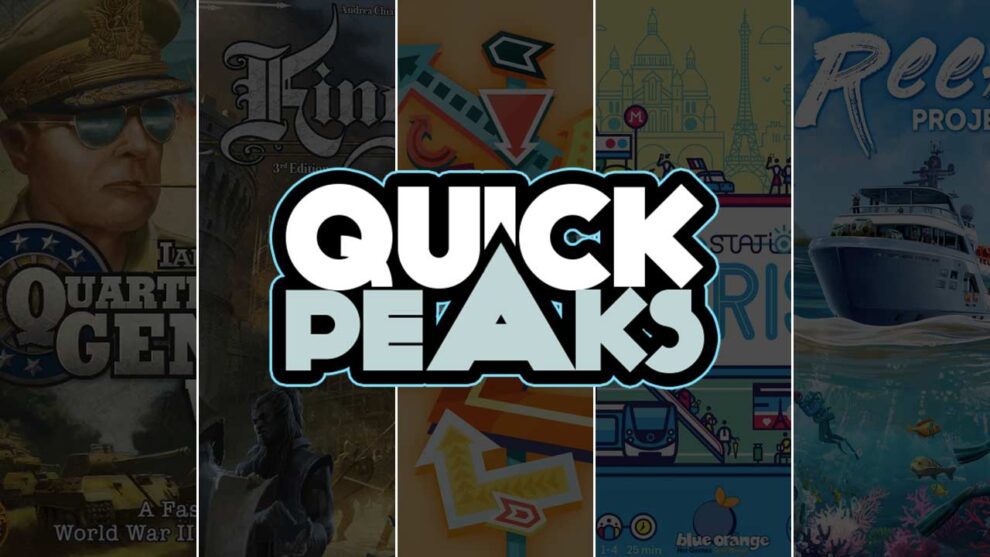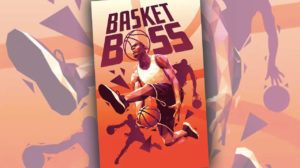Quartermaster General WW2: 2nd Edition – Justin Bell
Our partners at Ares Games recently sent a review copy of the 2020 card-driven, supply-line-obsessed wargame Quartermaster General WW2: 2nd Edition. Unfortunately, it arrived after my plays of the newer take on the system, Quartermaster General: East Front. In some ways, that was fine—I came into the base game material prepped and ready based on my experience with the newer game. Unlike Quartermaster General: East Front (two players only), Quartermaster General WW2 accommodates anywhere from 2-6 players. After my first six-player game, I’m not sure I would ever play this with less than the full player count.
That’s because at six players, QG WW2 is a blast, truly asymmetrical (right down to the differing number of both draw cards and placeable army and navy units), and wicked fast. As the leader of the Soviet Union, I was able to play interesting cards and make fun tactical decisions while working with the other Allied powers in the game (the US and the UK). Like QG: EF, the second edition of QG is surprisingly rules-light for a wargame, a category that I think I’ve been avoiding for too long because of an unsubstantiated fear of rules overhead and long playtimes.
The Allies won using the “Sudden Victory” rule: we were ahead by 30+ points at the end of the ninth round. The entire game took 70 minutes. Interesting decisions, quick turns, team-based play, and cool card powers? Count me in. While I struggle to imagine a world where I would try QG WW2 at two or three players (where each player has to manage many more decks and decisions), I highly recommend this for anyone who enjoys the theme, semi-coop games, wargames, and card-driven tactical fighting games that can be taught in less than 10 minutes.
Ease of entry?:
★★★★★ – No sweat
Would I play it again?:
★★★★★ – Will definitely play it again
Read more articles from Justin Bell.
Kingsburg (3rd Edition) – Justin Bell
2007’s Kingsburg is a top 10 game in my collection. It’s a classic, and it’s a game I love to break out a couple times each year to remember what games were like in “the good old days.” A second edition was released in 2017, and I picked up that version to replace my original copy so that I could get a couple of the expansions I never grabbed when they hit retail soon after the original game’s release. 2024 has been a fun, amazing, strange year…and for reasons that aren’t immediately clear (even to BGG, who created a page with some interesting notes), a third edition of Kingsburg was released this year, so our partners at Asmodee sent a copy for review.
The third edition of the game stumbles, and it stumbles badly. The new board (a board that I didn’t think needed another version) is now about half the size of the first and second edition boards, with a notable omission—soldiers are no longer tracked on the board, only through tokens collected during play. That means no one really knows how well anyone else is doing until they announce their soldier and reinforcement totals at the end of a round. Reinforcement tokens are tiny chits, as are all the previously wooden resource pieces. This new version only has three of the six expansions, omitting the event cards (which even I didn’t love, but appreciated their inclusion in the second edition) as well as the extra advisor tokens that change up the rewards provided by each advisor.
It’s a net negative result, and during my first five-player game of Kingsburg (3rd Edition), I was surprised how many times I commented out loud that this version just looks and feels cheaper than the second edition released a few years ago. Kingsburg is still Kingsburg, so rolling dice during the productive seasons and snaking your friends has not changed, and thankfully the rules seemed consistent between these last two versions. But in an age where nearly every old Euro gets a deluxe treatment, how has Kingsburg gotten “undeluxified” while so many other classics get triple-layer player boards, metal coins, and a rulebook with a linen finish?
Ease of entry?:
★★★★★ – No sweat
Would I play it again?:
★☆☆☆☆ – Would play again but will cry about it
Read more articles from Justin Bell.
It’s Obvious – Justin Bell
I had a group of eight players at my house recently, so I broke out It’s Obvious (2024, Friendly Skeleton) since it was one of the few review copies on my shelf that catered to such a large audience. The rules are short—a question card is revealed, showing a simple binary choice that players secretly have to vote for using their black or white voting card. One player is named the Host and that player takes all votes, shuffles them together, then displays which choice was picked by more players, thereby being known as the “obvious” answer to the question. All other answers are now known as “oblivious”, because they are in the minority.
Banter ensues, and when players are ready, a countdown commences before each player points at a person they believe is oblivious. The person being pointed at by the most other players must reveal their original vote, and if this was correct, play continues until all oblivious players have been outed or a mistake is made by the majority…the winning team is the one who survives this process with their team intact. That’s the whole game, but the manual encourages multiple plays by playing more question cards.
“I think this game is for groups that love banter,” said one player after our game. I had to agree, because the question we drew—”Sleep on your back OR sleep on your stomach?”—didn’t provide a lot of clues on what we should guess about other players. How should I know which way my gaming friends sleep? Four of the eight players represented couples who knew the answer of their partner, but no one else could have guessed at that. Three of our eight players were side sleepers; how should they answer? It’s Obvious is a fun idea but I’m not sure it’s a game, in the traditional sense. But, great news—you could play it for 10 minutes or an hour to suit the tastes of your gaming group.
Ease of entry?:
★★★★★ – No sweat
Would I play it again?:
★★☆☆☆ – Would play again but would rather play something else
Read more articles from Justin Bell.
Next Station: Paris – Justin Bell
Next Station: Paris (2024, Blue Orange Games) is the third game in the Next Station series (London, Tokyo)…and it’s fair to say at this point that “you get what you get” with this gaming system.
Next Station: Paris is a “flip-and-write” game where cards are flipped to dictate the rules for the current turn for all players. Using one of four colored pencils to start at various points on a map of Paris, players must build the best route network using a symbology mechanic that intersects with a scoring system tied to maximizing the number of stations that are connected in both single districts as well as city-wide. Newer additions to Next Station: Paris include monuments, a central station that has more connection points, and overhead crossings that help spike scores. Like the other games, an advanced variant features public milestones that provide additional ways to score.
I like the Next Station system, but it always feels like a solo activity best done alone, as opposed to a solo activity best played with three friends who are quietly working by themselves. Play is snappy, cards get flipped, and it always feels like the best way to navigate a round is to hit as many stations in the first district as possible (so, maybe 4-5) then hit a lot of other districts to boost a round score into the high 30s or low 40s. I played three games in about 40 minutes and got the same vibes as when I reviewed Next Station: London—fun, a nice activity while watching NFL football in the background, but nothing I would play over other more dynamic roll/flip-and-write systems.
Ease of entry?:
★★★★☆ – The odd bump or two
Would I play it again?:
★★★☆☆ – Wouldn’t suggest it, but would happily play it
Read more articles from Justin Bell.
Reef Project – Justin Bell
At a recent game night, a friend wanted to break out Reef Project, a game released earlier this year and published by one of my favorite partners, Board&Dice. One look at the action and I was down to jump in, so we did a three-player game and had a great time at the table.
Reef Project gives it to you straight—it’s a medium-weight Euro with tracks, efficient ways to make your way around the sprawling map thanks to “reef balls” (yes, the actual term in the rulebook), an area control mechanic, variable player powers, private end-game milestone cards, and any number of other things that scream Stock Eurogame Design Elements, right down to a theme that didn’t really matter once the game got rolling.
But in the words of all three players by the end, Reef Project is immensely satisfying. I’m not sure about the value of one of the game’s tracks—the Diver track, which awards 12 points for the person who comes out ahead but six points even if you come in third—but the game is an otherwise snappy affair, with quick turns, a project card mechanic that helps drive players to different destinations to earn awards, and crew tiles that provide interesting ways to combo turns. I don’t know a lot of people who have played Reef Project (which I saw for the first time at Gen Con 2024) but I’m hoping others get the chance to try the game.
Ease of entry?:
★★★☆☆ – There were a few questions
Would I play it again?:
★★★★☆ – Would like to play it again
Read more articles from Justin Bell.















Add Comment